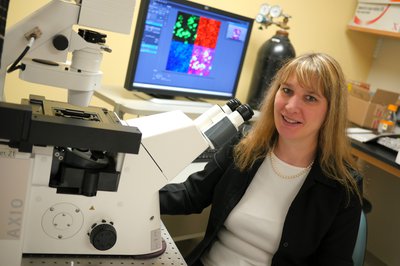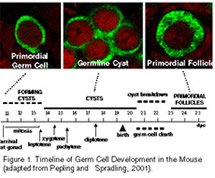Melissa E. Pepling

Melissa E. Pepling
Professor and Chair
CONTACT
Biology
110 Life Sciences Complex
Email: mepeplin@syr.edu
Office: 315.443.4541
PROGRAM AFFILIATIONS
Biochemistry
Biotechnology
Degrees
- Ph.D., SUNY Stony Brook (1995)
- M.S., Adelphi University (1988)
- B.S., Cornell University (1985)
Social/Academic Links
Courses Taught
- BIO 425: Cell & Developmental Biology Laboratory
- BIO 503: Developmental Biology
Regulation of mouse oocyte development; Hormone signaling in oocyte differentiation.
Research Spotlight

The Pepling Lab specializes in the study of oocytes (female germ cells), hormone signaling, and ovarian organ culture.
The pool of primordial follicles present at birth represents the total population of germ cells available to a female during her entire reproductive life. Establishment of this source of oocytes is absolutely essential for fertility. Shortly after forming, female germ cells undergo a series of incomplete cell divisions resulting in clusters called cysts. Just after birth, mouse germ cell cysts break down into individual oocytes that are surrounded by pre-granulosa cells to form primordial follicles. During cyst breakdown, a subset of oocytes in each cyst dies by programmed cell death with only a third of the initial number of oocytes surviving. The long-term goal of Dr. Pepling's research is to understand the mechanisms that regulate cyst breakdown and programmed cell death to establish the primordial follicle pool in the mouse ovary.
- Toothaker J.M., Roosa, K., Voss, A.E., Getman, S.M. and Pepling, M.E. (2022). Oocyte survival and follicle formation in an estrogen deficient environment. Endocrine Research 47, 45-55. https://doi.org/10.1080/07435800.2021.2011907
- Burton, J.N., Luke, A.J., and Pepling, M.E. (2022). Regulation of primordial follicle formation by KIT signaling through the PI3 Kinase pathway. Biology of Reproduction 106, 515-525. https://doi.org/10.1093/biolre/ioab204
- Wang, X. and Pepling, M.E. (2021). Regulation of Meiotic Prophase One in Mammalian Oocytes. Frontiers in Cell and Developmental Biology 9, 1291.
https://doi.org/10.3389/fcell.2021.667306 - O’Connell, J.M. and Pepling, M.E. (2021). Primordial Follicle Formation - Some Assembly Required. Current Opinion in Endocrine and Metabolic Research 18, 118-127.
https://doi.org/10.1016/j.coemr.2021.03.005 - Burks, D.M., McCoy, M.R., Dutta, S., Mark- Kappeler, C.J., Hoyer, P.B., and Pepling, M.E. (2019). Molecular analysis of the effects of steroid hormones on meiotic prophase I progression. Reproductive Biology and Endocrinology 17, 105.
- Pepling, M.E. and Lei, L. (2018). Oocyte Nests/Germline Cysts in Encyclopedia of Reproduction, 2nd edition, Volume 3 Gametogenesis, Fertilization and Early Development (eds. W. Yan and J. McCarrey). Elsevier.
- Pepling, M.E. and Burton, J. (2018). Fetal/Gonadogenesis in Encyclopedia of Reproduction, 2nd edition, Volume 2. Female Reproduction. (eds. J. Flaws and T. Spencer). Elsevier.
- Pepling, M.E. (2017). Differentiation and Function of the Female Reproductive System in Comprehensive Toxicology, 3rd edition, Reproductive and Endocrine Toxicology volume. (ed. A. Keating). Elsevier Ltd.
- Dutta, S., Burks, D.M. and Pepling, M.E. (2016). Arrest at the diplotene stage of meiotic prophase I is delayed by progesterone but is not required for primordial follicle formation in mice. Reproductive Biology and Endocrinology 14(1):82, 1-8.
- Pepling, M.E. (2016). Nursing the Oocyte. Science 352, 35-36.
- Sun, T., Pepling, M.E. and Diaz, F.J. (2015). Lats1 deletion causes increased germ cell apoptosis and follicular cysts in mouse ovaries. Biology of Reproduction 93(1):22, 1-11.
- Dutta, S., Mark-Kappeler, C.J., Hoyer, P. B. and Pepling, M.E. (2014) The Steroid Hormone Environment during Primordial Follicle Formation in Perinatal Mouse Ovaries. Biology of Reproduction, in press.
- Sivakumar, K.K., Stanley, J.A., Arosh, J.A., Pepling, M.E., Burghardt, R.C. and Banu, S. (2014) Prenatal Exposure to Chromium induces Early Reproductive Senescence by increasing Germ Cell Apoptosis and advancing Germ Cell Cyst Breakdown in the F1 Offspring. Developmental Biology 388, 22-34.
- Jones, R.L. and Pepling, M.E. (2013) Kit Signaling is Involved in Murine Primordial Follicle Formation. Developmental Biology 382, 186-197.
- Jones, R.L. and Pepling, M.E. (2013) Role of the Anti-Apoptotic Proteins BCL2 and MCL1 in the Neonatal Mouse Ovary. Biology of Reproduction 88(2):46, 1-8.
- Karavan, J. and Pepling, M.E., (2012) Effects of Estrogenic Compounds on Neonatal Oocyte Development. Reproductive Toxicology 34, 51-56.
- Pepling, M.E. (2012) Follicular Assembly: Mechanisms of Action. Reproduction 143, 139-149.
